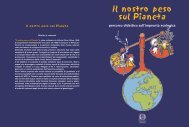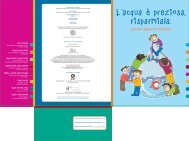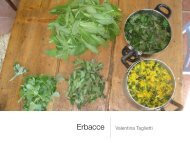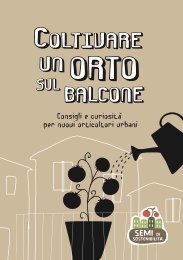Myanmar Protected Areas: Context, Current Status ... - Istituto Oikos
Myanmar Protected Areas: Context, Current Status ... - Istituto Oikos
Myanmar Protected Areas: Context, Current Status ... - Istituto Oikos
Create successful ePaper yourself
Turn your PDF publications into a flip-book with our unique Google optimized e-Paper software.
MAINMAHLA KYUN<br />
Site ID 23<br />
Locality Ayeyawaddy Region, Bogale Township<br />
Coordinates N 15° 58’, E 95° 17’<br />
Size (km²) 137<br />
Altitude (m. asl) 0 – 30<br />
<strong>Myanmar</strong> category Wildlife Sanctuary<br />
IUCN category IV<br />
Site Governance Nature and Wildlife Conservation Division<br />
Boundaries Demarcated<br />
Year gazetted 1993<br />
Protection level Total<br />
Main purposes<br />
Habitat Mangrove Forest<br />
Conservation, Cultural heritage, Recreation/ Ecotourism,<br />
Research/ Education<br />
Key resources Mangroves, Salt-water Crocodile, Birds spp.<br />
Legend of topographic maps<br />
Head Quarters<br />
Ranger Post<br />
Towns<br />
<strong>Protected</strong> <strong>Areas</strong><br />
State/Region Boundaries<br />
Roads<br />
Water areas<br />
Rivers<br />
Elevation<br />
5.800 m. asl<br />
0 m. asl<br />
Legend of satellite maps<br />
Water Depth Vegetation Density<br />
Deep<br />
Shallow<br />
High<br />
Low<br />
SITE DESCRIPTION<br />
Mainmahla Kyun Wildlife Sanctuary is situated in Bogalay<br />
Township, Ayeyawaddy Region. It is an island of low flat land<br />
delta area and it is located very near to the open sea. The site is<br />
fringed by the Bogalay River in the east and by the Kadonkani<br />
River in the west. Many small streams are present as a network<br />
in the Sanctuary and accessibility into the streams is governed<br />
by the tide. The Sanctuary is covered with mangrove forest<br />
only. Soil type is tidal mud and silt. Annual rainfall of the<br />
site ranges from 2,500 to 3,000 mm. Myauktayar pagoda, a<br />
famous pagoda of the region, is situated to the south-east of<br />
the Sanctuary. Mainmahla Kyun is one of <strong>Myanmar</strong>’s ASEAN<br />
Heritage sites.<br />
NATURAL RESOURCES<br />
Mangroves are the main resources of the site. About 40<br />
mangrove species have been recorded; 53 medicine plant<br />
species, 11 orchid species, 18 mammals, including Irrawaddy<br />
dolphin species, 117 bird species, 59 fish species, 12 shrimp<br />
species, 10 crab species, 35 butterfly species and 26 snake<br />
species have been recorded by the Sanctuary staff.<br />
MANAGEMENT<br />
Annual management plan<br />
Management actions in place:<br />
• Fire protection and infrastructure renovation<br />
• Crocodile conservation<br />
• Monitoring animal populations and tree cover<br />
• Regular patrolling<br />
• Awareness raising<br />
<strong>Myanmar</strong> <strong>Protected</strong> <strong>Areas</strong><br />
Management problems:<br />
• Budget<br />
• Inadequate staff<br />
Required actions:<br />
• Increase patrolling<br />
• Communication equipments<br />
• Field equipments<br />
• Guard post<br />
STAFF / RESOURCES<br />
The administrative office is located in Bogalay town which is<br />
12 miles away from the site in the north. The conservation and<br />
research activities have been performed with 14 permanent<br />
forest staff and seven daily wages staff. Two crocodile<br />
conservation camps with natural pond are located on the west<br />
side of the island. Monitoring, research and capacity building<br />
activities have also been conducted in coordination and<br />
collaboration with both local and international organizations<br />
and agencies. The park facilities include one head office, 2<br />
ranger posts, three small field camps, an education centre<br />
and a boat.<br />
TOURISM<br />
The site is occasionally busy with pilgrims mainly from<br />
the villages of that area to the Myauktayar pagoda. The<br />
development of ecotourism is an objective of the site and a<br />
few foreign tourists have visited the site.<br />
A guest house was built by a local environmental NGO, FREDA,<br />
on the Byone hmwe Island which is situated on the west side<br />
of the Kadonkani River facing the Sanctuary in the east.<br />
60 61<br />
THREATS<br />
• Gathering Terrestrial Plants (collection of ferns, tha bot<br />
and nipa palm)<br />
• Logging & Wood Harvesting (mangrove wood for charcoal<br />
and firewood)<br />
• Fishing & Harvesting of Aquatic Resources (poison fishing<br />
practice)<br />
LAND USE AND HUMAN ACTIVITIES<br />
INSIDE<br />
• Conservation<br />
• Research<br />
• Recreation<br />
Conservationists, researchers and tourists are allowed to<br />
come to the Sanctuary with permission.<br />
OUTSIDE<br />
• Fishery<br />
• Restricted area (reserved forest)<br />
• Mangrove plantation






